brake PORSCHE CAYNNE 2010 1.G Information Manual
[x] Cancel search | Manufacturer: PORSCHE, Model Year: 2010, Model line: CAYENNE, Model: PORSCHE CAYENNE 2010 1.GPages: 68, PDF Size: 4.52 MB
Page 6 of 68
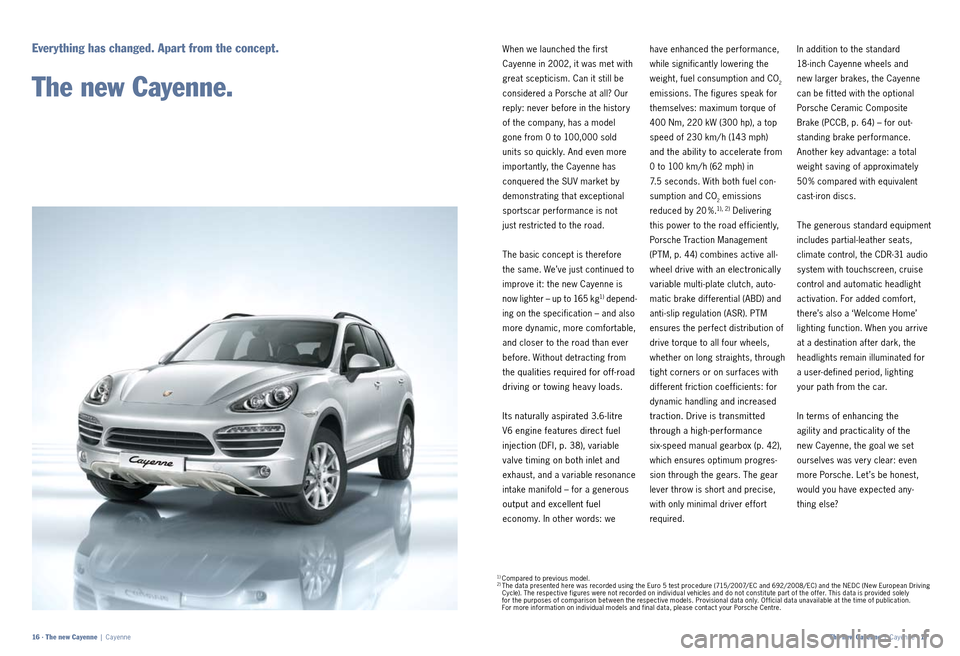
When we launched the first
Cayenne in 2002, it was met with
great scepticism. Can it still be
considered a Porsche at all? Our
reply: never before in the history
of the company, has a model
gone from 0 to 100,000 sold
units so quickly. And even more
importantly, the Cayenne has
conquered the SUV market by
demonstrating that exceptional
sportscar performance is not
just restricted to the road.
The basic concept is therefore
the same. We’ve just continued to
improve it: the new Cayenne is
now lighter – up to 165 kg1) depend
ing
on the specification – and also
more dynamic, more comfortable,
and closer to the road than ever
before. Without detracting from
the
qualities required for off road
driving or towing heav y loads.
Its naturally aspirated 3.6 litre
V6 engine features direct fuel
injection (DFI, p. 38), variable
valve timing on both inlet and
exhaust, and a variable resonance
intake manifold – for a generous
output and excellent fuel
economy. In other words: we have enhanced the performance,
while significantly lowering the
weight, fuel consumption and CO
2
emissions. The figures speak for
themselves: maximum torque of
400 Nm, 220 kW (300 hp), a top
speed of 230 km/ h (143 mph)
and the abilit y to accelerate from
0 to 100 km/ h (62 mph) in
7.5 se conds. With both fuel con
sumption and CO
2 emissions
reduced by 20 %.
1), 2) Delivering
this power to the road efficiently,
Porsche Traction Management
(PTM, p. 44) combines active all
wheel drive
with an electron ically
variable
multi plate clutch, auto
matic brake dif ferential (ABD) and
anti slip regulation (ASR). PTM
ensures the perfect distribution of
drive torque to all four wheels,
whether on long straights, through
tight corners or on surfaces with
dif ferent friction coef ficients: for
dynamic handling
and increased
traction. Drive is transmit ted
through a high performance
six speed manual gearbox (p. 42),
which ensures optimum progres
sion through the gears. The gear
lever throw is short and precise,
with only minimal driver ef fort
required. In addition to the standard
18
inch Cayenne wheels and
new larger brakes, the Cayenne
can be fit ted with the optional
Porsche Ceramic Composite
Brake (PCCB, p. 64) – for out
standing brake performance.
Another key advantage: a total
weight saving of approximately
50 % compared with equivalent
cast iron discs.
The generous standard equipment
includes partial leather seats,
climate control, the CDR 31 audio
system with touchscreen, cruise
control and automatic headlight
activation. For added comfort,
there’s also a ‘Welcome Home’
lighting function. When you arrive
at a destination af ter dark, the
headlights remain illuminated for
a user defined period, lighting
your path from the car.
In terms of enhancing the
agility
and practicalit y of the
new
Cayenne, the goal we set
ourselves was very clear: even
more Porsche. Let ’s be honest,
would you have expected any
thing else?
Everything has changed. Apart from the concept.
The new Cayenne.
1) Compared to previous model.2) The data presented here was recorded using the Euro 5 test procedure (715/2007/ EC and 692/2008/ EC) and the NEDC (New European Driving
Cycle). The respective figures were not recorded on individual vehicles and do not constitute part of the of fer. This data is provided solely
for the purposes of comparison bet ween the respective models. Provisional data only. Of ficial data unavailable at the time of publication.
For more information on individual models and final data, please contact your Porsche Centre.
The new Cayenne | Cayenne · 17
16 · The new Cayenne | Cayenne
Page 8 of 68
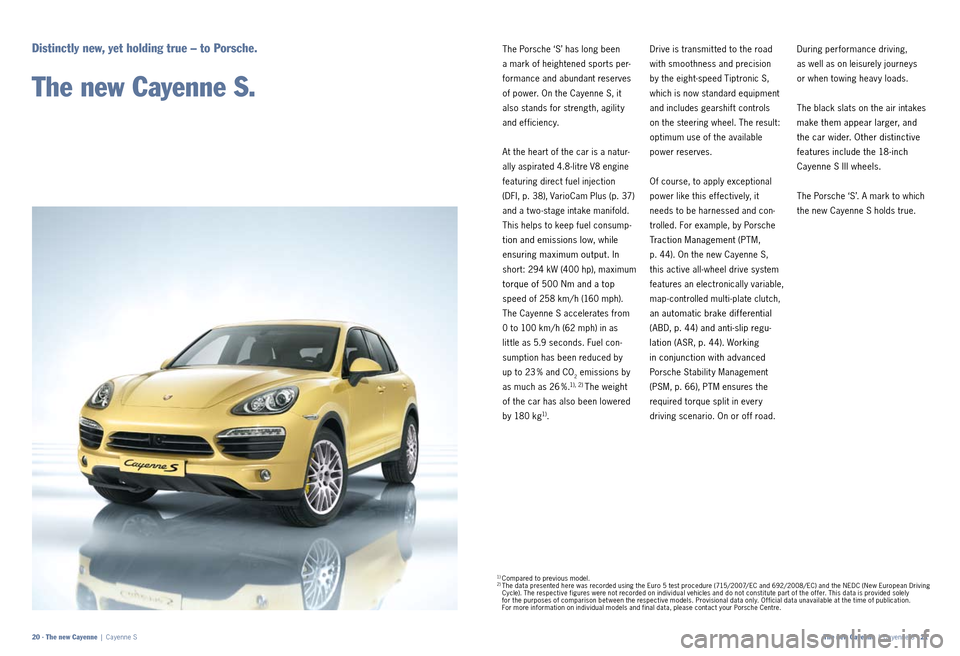
The Porsche ‘S’ has long been
a mark of heightened sports per
formance and abundant reserves
of power. On the Cayenne S, it
also stands for strength, agilit y
and efficiency.
At the heart of the car is a natur
ally aspirated 4.8 litre V8 engine
featuring direct fuel injection
(DFI, p. 38), VarioCam Plus (p. 37)
and a t wo stage intake manifold.
This helps to keep fuel consump
tion and emissions low, while
ensuring maximum output. In
short: 294 kW (400 hp), maximum
torque of 500 Nm and a top
speed of 258 km/ h (160 mph).
The Cayenne S accelerates from
0 to 100 km/ h (62 mph) in as
lit tle as 5.9 seconds. Fuel con
sumption has been reduced by
up to 23 % and CO
2 emissions by
as much as 26 %.
1), 2) The weight
of the car has also been lowered
by 180 kg
1). Drive is transmit ted to the road
with smoothness and precision
by the eight
speed Tiptronic S,
which is now standard equipment
and includes gearshif t controls
on the steering wheel. The result:
optimum use of the available
power reserves.
Of course, to apply exceptional
power like this ef fectively, it
needs to be harnessed and con
trolled. For example, by Porsche
Traction Management (PTM,
p. 44). On the new Cayenne S,
this active all wheel drive system
features an electronically variable,
map controlled multi plate clutch,
an automatic brake differential
(ABD, p. 44) and anti slip regu
lation (ASR, p. 44). Working
in conjunction with advanced
Porsche Stabilit y Management
(PSM, p. 66), PTM ensures the
required torque split in every
driving scenario. On or of f road. During performance driving,
as well as on leisurely journeys
or when towing heav y loads.
The black slats on the air intakes
make them appear larger, and
the car wider. Other distinctive
features include the 18 inch
Cayenne S III wheels.
The Porsche ‘S’. A mark to which
the new Cayenne S holds true.
Distinctly new, yet holding true – to Porsche.
The new Cayenne S.
1) Compared to previous model.2) The data presented here was recorded using the Euro 5 test procedure (715/2007/ EC and 692/2008/ EC) and the NEDC (New European Driving
Cycle). The respective figures were not recorded on individual vehicles and do not constitute part of the of fer. This data is provided solely
for the purposes of comparison bet ween the respective models. Provisional data only. Of ficial data unavailable at the time of publication.
For more information on individual models and final data, please contact your Porsche Centre.
The new Cayenne | Cayenne S · 21
20 · The new Cayenne | Cayenne S
Page 13 of 68
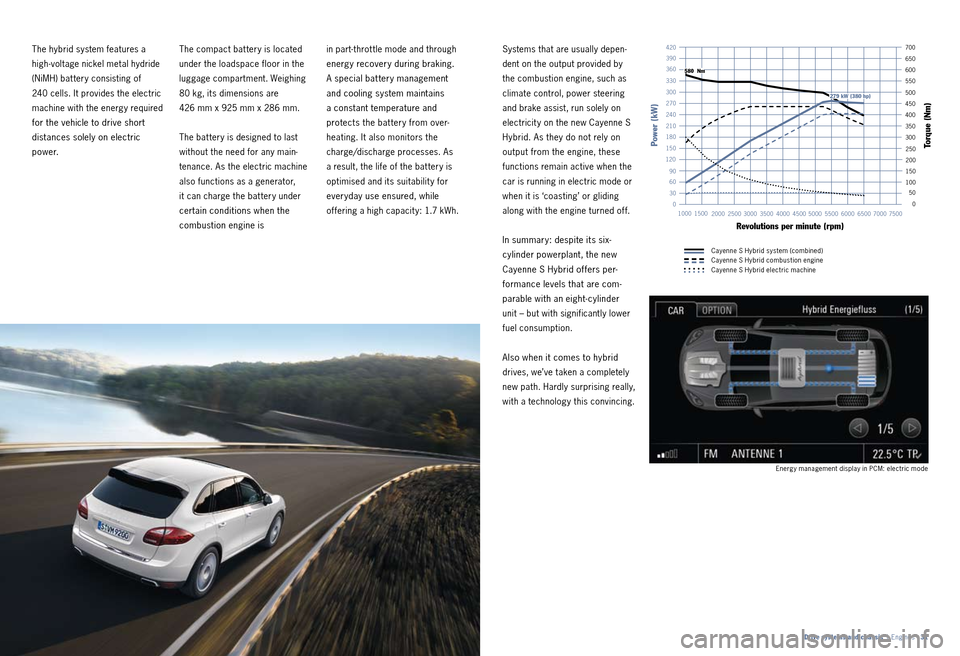
in partthrot tle mode and through
energy recovery during braking.
A special bat tery management
and cooling system maintains
a constant temperature and
pro
tects the bat ter y from over
heating. It also monitors the
charge/discharge processes. As
a result, the life of the bat tery is
optimised and its suitabilit y for
everyday use ensured, while
offering a high capacit y: 1.7 kWh. Systems that are usually depen
dent on the output provided by
the combustion engine, such as
climate control, power steering
and brake assist, run solely on
electricit y on the new Cayenne S
Hybrid. As they do not rely on
output from the engine, these
functions remain active when the
car is running in electric mode or
when it is ‘coasting’ or gliding
along with the engine turned of f.
In summary: despite its six
cylinder powerplant, the new
Cayenne S Hybrid offers per
formance levels that are com
parable with an eight cylinder
unit – but with significantly lower
fuel consumption.
Also when it comes to hybrid
drives, we’ve taken a completely
new path. Hardly surprising really,
with a technology this convincing.
The compact bat tery is located
under the loadspace floor in the
luggage compartment. Weighing
80 kg, its dimensions are
426 mm x 925 mm x 286 mm.
The bat tery is designed to last
without the need for any main
tenance. As the electric machine
also functions as a generator,
it can charge the bat tery under
certain conditions when the
combustion engine is
The hybrid system features a
high
voltage nickel metal hydride
(NiMH) bat tery consisting of
240 cells. It provides the electric
machine with the energy required
for the vehicle to drive short
distances solely on electric
power.
Drive systems and chassis | Engines · 31
Energy management display in PCM: electric mode
100
50
0
300 350
400
450
500 550 600
650
0
30 60 90
120
150 180 210 240 270
300
330
150 200
250
Power (kW)
Torque (Nm)
1500
7500
2000 2500 3000 3500 4000 4500 5000 5500 6000 6500 7000
1000
Revolutions per minute (rpm)
360 390 420
700 580 Nm
279 kW (380 hp)
Cayenne S Hybrid system (combined)
Cayenne S Hybrid combustion engine
Cayenne S Hybrid electric machine
Page 16 of 68

Standard on the new Cayenne
Diesel, new Cayenne S, new
Cayenne S Hybrid and new
Cayenne Turbo. Available as an
option for the new Cayenne
in conjunction with the optional
Tiptronic S.
VarioCam Plus.
VarioCam Plus creates t wo en
gines out of one by steplessly
adjusting the inlet valve timing
and lift.
The system dif ferentiates
bet ween normal road usage and
performance driving, adapting
seamlessly as driver inputs
change. All functions are auto
matically controlled by the
engine management system.
All you experience is responsive
acceleration and ultra smooth
running characteristics. Inlet valve
timing is steplessly adjusted. To
improve response when starting
from cold, for example, VarioCam
Plus selects the higher lif t set ting
and retards valve timing.
At medium revs and minimal
load, the valve lif t is lowered and
timing advanced to minimise fuel
consumption and emissions. At
low engine speeds in particular,
VarioCam Plus significantly im
proves fuel economy. To achieve maximum power and torque, the
valve lif t is raised and the timing
advanced.
Overall, the system provides
greater performance with rela
tively modest fuel consumption.
Standard on the new Cayenne S
and new Cayenne Turbo.
Variable valve timing.
The V6 engine in the Cayenne
features variable valve timing
on both inlet and exhaust. The camshaft phase angles
are continuously varied by
the engine management system
via rotary vane adjusters.
On the new Cayenne S Hybrid, the
inlet valve timing is continuously
adjusted.
The key benefits include bet ter
fuel economy and lower emis
sions. It also helps to generate
greater power and torque –
even at low engine speeds.
Standard on the new Cayenne
and new Cayenne S Hybrid.
The starter motor has been re
vised to cope with the additional
demands of the system, and
the bat tery charge and life are
continuously monitored. The
bat tery and starter motor are
replacement parts that are
subject to greater wear and
tear with frequent use of the
auto start /stop function.
systems remain switched on and
the standard climate control
continues to maintain the selected
temperature. The only changes
you’ll perceive: peace and quiet
and – thanks to greater fuel
economy – also peace of mind.
The system is deactivated in
certain situations, e.g. if the
outside temperature is very
high or the bat tery charge is low.
Auto start/stop function.
The new Cayenne models that
are equipped with the new eight
speed Tiptronic S also feature an
auto start /stop function. If, for
example, you stop at traf fic lights
with your foot on the brake pedal,
the auto start /stop function will
automatically cut the engine.
Although the engine is not running,
all audio and communication
The heart of every Porsche.
Applying power with intelligence.
Engine technology.
VarioCam Plus
Drive systems and chassis | Engine technology · 37
Page 20 of 68
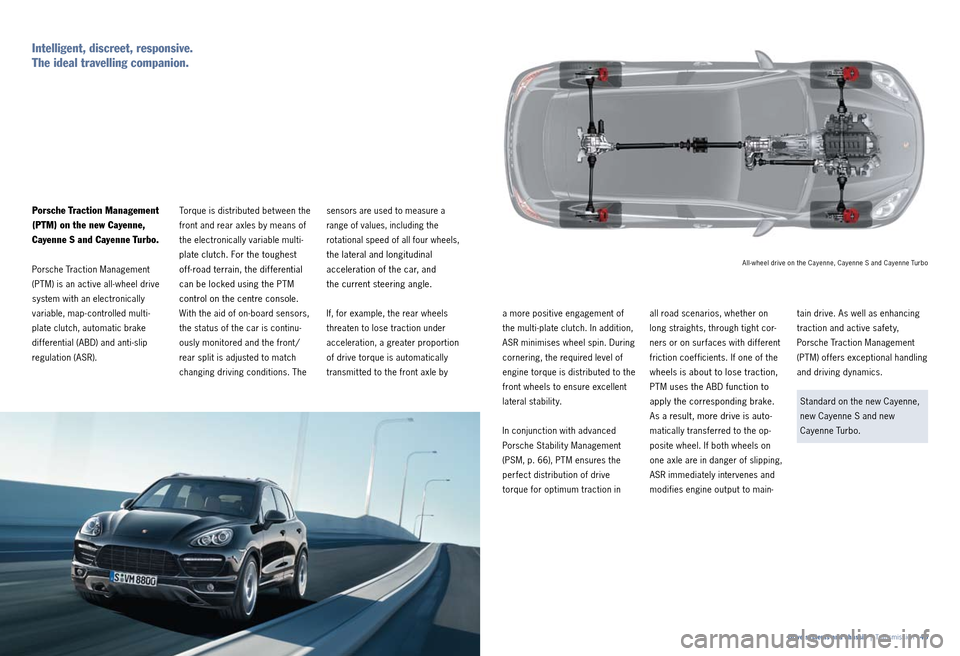
sensors are used to measure a
range of values, including the
rotational speed of all four wheels,
the lateral and longitudinal
acceleration of the car, and
the current steering angle.
If, for example, the rear wheels
threaten to lose traction under
acceleration, a greater proportion
of drive torque is automatically
transmit ted to the front axle by a more positive engagement of
the multi
plate clutch. In addition,
ASR minimises wheel spin. During
cornering, the required level of
engine torque is distributed to the
front wheels to ensure excellent
lateral stabilit y.
In conjunction with advanced
Porsche Stabilit y Management
(PSM, p. 66), PTM ensures the
perfect distribution of drive
torque for optimum traction in all road scenarios, whether on
long straights, through tight cor
ners or on surfaces with dif ferent
friction coef ficients. If one of the
wheels is about to lose traction,
PTM uses the ABD function to
apply the corresponding brake.
As a result, more drive is auto
matically transferred to the op
posite wheel. If both wheels on
one axle are in danger of slipping,
ASR immediately intervenes and
modifies engine output to main tain drive. As well as enhancing
traction and active safet y,
Porsche Traction Management
(PTM) of fers exceptional handling
and driving dynamics.
Standard on the new Cayenne,
new Cayenne S and new
Cayenne Turbo.
Torque is distributed bet ween the
front and rear axles by means of
the electronically variable multi
plate clutch. For the toughest
off road terrain, the differential
can be locked using the PTM
control on the centre console.
With the aid of on board sensors,
the status of the car is continu
ously monitored and the front /
rear split is adjusted to match
changing driving conditions. The
Porsche Traction Management
(PTM) on the new Cayenne,
Cayenne S and Cayenne Turbo.
Porsche Traction Management
(PTM) is an active all wheel drive
system with an electronically
variable, map controlled multi
plate clutch, automatic brake
dif ferential (ABD) and anti slip
regulation (ASR).
Intelligent, discreet, responsive.
The ideal travelling companion.
All wheel drive on the Cayenne, Cayenne S and Cayenne Turbo
Drive systems and chassis | Transmission · 45
Page 21 of 68
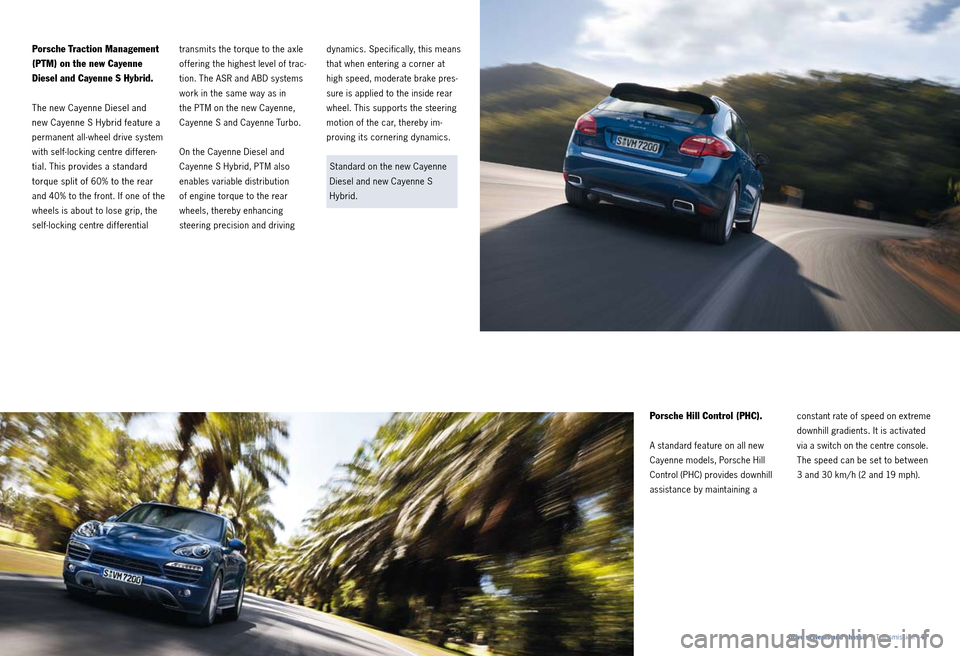
dynamics. Specifically, this means
that when entering a corner at
high speed, moderate brake pres
sure is applied to the inside rear
wheel. This supports the steering
motion of the car, thereby im
proving its cornering dynamics.
Standard on the new Cayenne
Diesel and new Cayenne S
Hybrid.
Porsche Hill Control (PHC).
A standard feature on all new
Cayenne models, Porsche Hill
Control (PHC) provides downhill
assistance by maintaining a constant rate of speed on extreme
downhill gradients. It is activated via a switch on the centre console.
The speed can be set to bet ween
3 and 30 km/ h (2 and 19 mph).
transmits the torque to the axle
offering the highest level of trac
tion. The ASR and ABD systems
work in the same way as in
the PTM on the new Cayenne,
Cayenne S and Cayenne Turbo.
On the Cayenne Diesel and
Cayenne S Hybrid, PTM also
enables variable distribution
of engine torque to the rear
wheels, thereby enhancing
steering precision and driving
Porsche Traction Management
(PTM) on the new Cayenne
Diesel and Cayenne S Hybrid.
The new Cayenne Diesel and
new Cayenne S Hybrid feature a
permanent all wheel drive system
with self locking centre differen
tial. This provides a standard
torque split of 60% to the rear
and 40% to the front. If one of the
wheels is about to lose grip, the
selflocking centre dif ferential
Drive systems and chassis | Transmission · 47
Page 23 of 68

Making headway without getting in a spin.
An approach we thoroughly support.
Chassis.
In of froad terrain, PT V Plus
reduces wheel spin on the rear
wheels – even when towing heav y
trailer loads. The electronically
controlled rear dif ferential can
be fully locked using the of f road
control on the centre console.
Optional for the new Cayenne,
new Cayenne S and new
Cayenne Turbo.
Porsche Active Suspension
Management (PASM).
PASM is an electronic damping
control system. It of fers con
tinuous adjustment of individual
damping forces based on current
road conditions and driving st yle.
During performance driving or
heav y of f road use, there is an
increased tendency for the body
to sway. PASM prevents this from
happening, thereby improving
stabilit y and occupant comfort. PASM has three setup modes:
‘Comfort ’, ‘Normal’ and ‘Sport ’.
Whichever one you select, the
system uses a series of sensors
to monitor the movement of the
body. It also gathers data on
lateral acceleration, steering
angle, brake pressure and engine
torque and modifies the damping
force on each individual wheel
in accordance with the selected
mode. PASM remains active at all times.
It automatically adapts to the
prevailing driving conditions,
enabling greater car control and
improving comfort and safet y.
Optional for the new Cayenne,
new Cayenne Diesel, new
Cayenne S and new Cayenne S
Hybrid. Standard on the new
Cayenne Turbo: air suspension
with PASM.
This transfers drive torque to the
outside rear wheel which supports
the steering motion of the car,
thereby improving its cornering
dynamics.
At slow and medium speeds, PT V
Plus considerably enhances agilit y
and steering precision. At high
speeds, during fast cornering and
under wheel spin, the mechanical
limited slip rear differential
ensures additional stabilit y. Also
on variable grip surfaces, in the
wet and on snow, PT V Plus –
combined with Porsche Traction
Management (PTM) and Porsche
Stabilit y Management (PSM) –
provides a major contribution to
active safety.
Porsche Torque Vectoring Plus
(PTV Plus).
A new system for enhancing
driving dynamics and stabilit y,
PT V Plus offers variable distribu
tion of engine torque to the rear
wheels and mechanical limited
slip rear dif ferential. Depending
on the steering angle, steering
speed, throt tle pedal position,
yaw velocit y and vehicle speed,
PT V Plus optimises steering re
sponse and precision by applying
brake pressure to the left or right
rear wheel, as required.
Specifically, this means that when
entering a corner at high speed,
moderate brake pressure is
applied to the inside rear wheel.
Porsche Active Suspension Management (PASM)
50 · Drive systems and chassis | ChassisDrive systems and chassis | Chassis · 51
Page 28 of 68
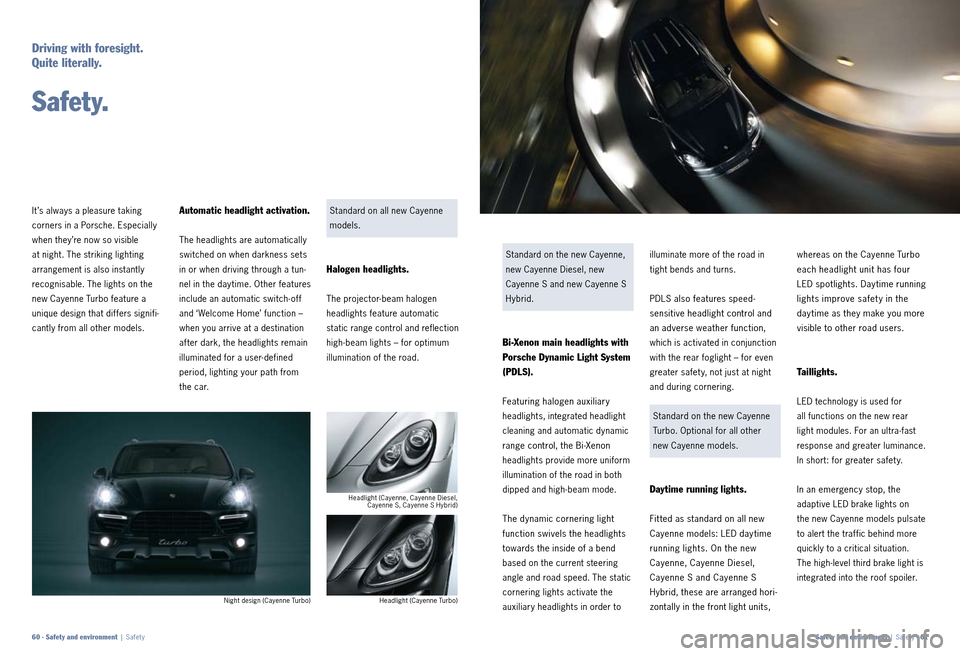
Standard on all new Cayenne
models.
Halogen headlights.
The projectorbeam halogen
headlights feature automatic
static range control and reflection
high beam lights – for optimum
illumination of the road.
Standard on the new Cayenne,
new Cayenne Diesel, new
Cayenne S and new Cayenne S
Hybrid.
Bi-Xenon main headlights with
Porsche Dynamic Light System
(PDLS).
Featuring halogen auxiliary
headlights, integrated headlight
cleaning and automatic dynamic
range control, the Bi Xenon
headlights provide more uniform
illumination of the road in both
dipped and high beam mode.
The dynamic cornering light
function swivels the headlights
towards the inside of a bend
based on the current steering
angle and road speed. The static
cornering lights activate the
auxiliary headlights in order to illuminate more of the road in
tight bends and turns.
PDLS also features speed
sensitive headlight control and
an adverse weather function,
which is activated in conjunction
with the rear foglight – for even
greater safet y, not just at night
and during cornering.
Standard on the new Cayenne
Turbo. Optional for all other
new Cayenne models.
Daytime running lights.
Fit ted as standard on all new
Cayenne models: LED day time
running lights. On the new
Cayenne, Cayenne Diesel,
Cayenne S and Cayenne S
Hybrid, these are arranged hori
zontally in the front light units, whereas on the Cayenne Turbo
each headlight unit has four
LED spotlights. Day time running
lights improve safet y in the
day time as they make you more
visible to other road users.
Taillights.
LED technology is used for
all functions on the new rear
light modules. For an ultra fast
response and greater luminance.
In short: for greater safet y.
In an emergency stop, the
adaptive LED brake lights on
the new Cayenne models pulsate
to alert the traf fic behind more
quickly to a critical situation.
The high level third brake light is
integrated into the roof spoiler.
Automatic headlight activation.
The headlights are automatically
switched on when darkness sets
in or when driving through a tun
nel in the day time. Other features
include an automatic switch of f
and ‘Welcome Home’ function –
when you arrive at a destination
after dark, the headlights remain
illuminated for a user defined
period, lighting your path from
the car.
It ’s always a pleasure taking
corners in a Porsche. Especially
when they’re now so visible
at night. The striking lighting
arrangement is also instantly
recog
nisable. The lights on the
new Cayenne Turbo feature a
unique design that differs signifi
cantly from all other models.
Driving with foresight.
Quite literally.
S a f e t y.
Night design (Cayenne Turbo) Headlight (Cayenne, Cayenne Diesel,
Cayenne S, Cayenne S Hybrid)
Headlight (Cayenne Turbo)
Safety and environment | Safet y · 61
60 · Safety and environment | Safet y
Page 29 of 68

All Cayenne models have internal
ly vented discs all round, ensuring
consistent performance during
heav y use. The front disc dimen
sions (diameter/thickness) are
350 mm/34 mm on the new
Cayenne and new Cayenne Diesel,
360 mm/36 mm on the new
Cayenne S and new Cayenne S
Hybrid, and 390 mm/38 mm on
the new Cayenne Turbo. All models have six
piston
monobloc aluminium brake
calipers at the front and four
piston equivalents at the rear.
The calipers are black on the new
Cayenne and new Cayenne Diesel
and silver on the new Cayenne S
and new Cayenne S Hybrid. On
the new Cayenne Turbo, they
feature a striking red paint finish. Braking is assisted by a tandem
booster and large brake master
cylinder. Further assistance is
provided by PSM (p. 66).
The pads are equipped with
individual wear sensors. When
new pads are required, a
warning light is illuminated in
the instrument cluster.
Electric parking brake.
Manually activated and deactivat
ed, the electric parking brake
releases automatically as you drive
off.
Automatic hold function.
With the automatic hold function,
you can pull away on the flat or a
slope without ever rolling back.
The system automatically detects
when the vehicle has come to a
halt on an uphill gradient. PSM then
maintains the brake pressure at all
four wheels for a brief period to
prevent the vehicle from moving in
the opposite direction.
Braking systems.
Porsche brakes are renowned
worldwide as the benchmark in
performance
and durabilit y.
Equipped with new braking
systems, the new Cayenne
models continue this tradition.
The larger brakes of fer excellent
deceleration – even when the
car is fully laden with five adult
occupants, a full complement
of luggage and a braked trailer
load of up to 3,500 kg (Cayenne
with manual gearbox: 2,700 kg).
Outstanding brake performance.
To the point.
Standard braking system
(Cayenne/Cayenne Diesel) Standard braking system
(Cayenne S/Cayenne S Hybrid) Standard braking system (Cayenne Turbo)
Safety and environment
| Safet y · 63
62 · Safety and environment | Safet y
Page 30 of 68
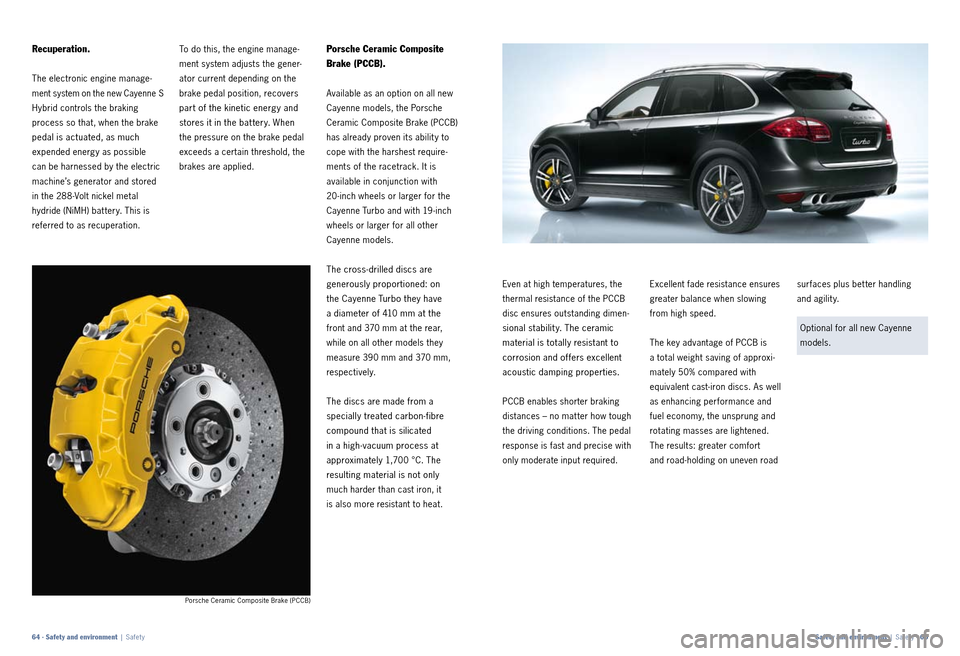
Porsche Ceramic Composite Brake (PCCB)
To do this, the engine manage
ment system adjusts the gener
ator current depending on the
brake pedal position, recovers
part of the kinetic energy and
stores it in the bat tery. When
the pressure on the brake pedal
exceeds a certain threshold, the
brakes are applied.
Porsche Ceramic Composite
Brake (PCCB).
Available as an option on all new
Cayenne models, the Porsche
Ceramic Composite Brake (PCCB)
has already proven its abilit y to
cope with the harshest require
ments of the racetrack. It is
available in conjunction with
20 inch wheels or larger for the
Cayenne Turbo and with 19 inch
wheels or larger for all other
Cayenne models.
The cross drilled discs are
generously proportioned: on
the Cayenne Turbo they have
a diameter of 410 mm at the
front and 370 mm at the rear,
while on all other models they
measure 390 mm and 370 mm,
respectively.
The discs are made from a
specially treated carbon fibre
compound that is silicated
in a high vacuum process at
approximately 1,700 °C. The
resulting material is not only
much harder than cast iron, it
is also more resistant to heat. Even at high temperatures, the
thermal resistance of the PCCB
disc ensures outstanding dimen
sional stabilit y. The ceramic
material is totally resistant to
corrosion and offers excellent
acoustic damping properties.
PCCB enables shorter braking
distances – no mat ter how tough
the driving conditions. The pedal
response is fast and precise with
only moderate input required. Excellent fade resistance ensures
greater balance when slowing
from high speed.
The key advantage of PCCB is
a total weight saving of approxi
mately 50% compared with
equivalent cast iron discs. As well
as enhancing performance and
fuel economy, the unsprung and
rotating masses are lightened.
The results: greater comfort
and road holding on uneven road surfaces plus bet ter handling
and agility.
Optional for all new Cayenne
models.
Recuperation.
The electronic engine manage
ment system on the new Cayenne S
Hybrid controls the braking
process so that, when the brake
pedal is actuated, as much
expended energy as possible
can be harnessed by the electric
machine’s generator and stored
in the 288 Volt nickel metal
hydride (NiMH) bat tery. This is
referred to as recuperation.
Safety and environment | Safet y · 65
64 · Safety and environment | Safet y